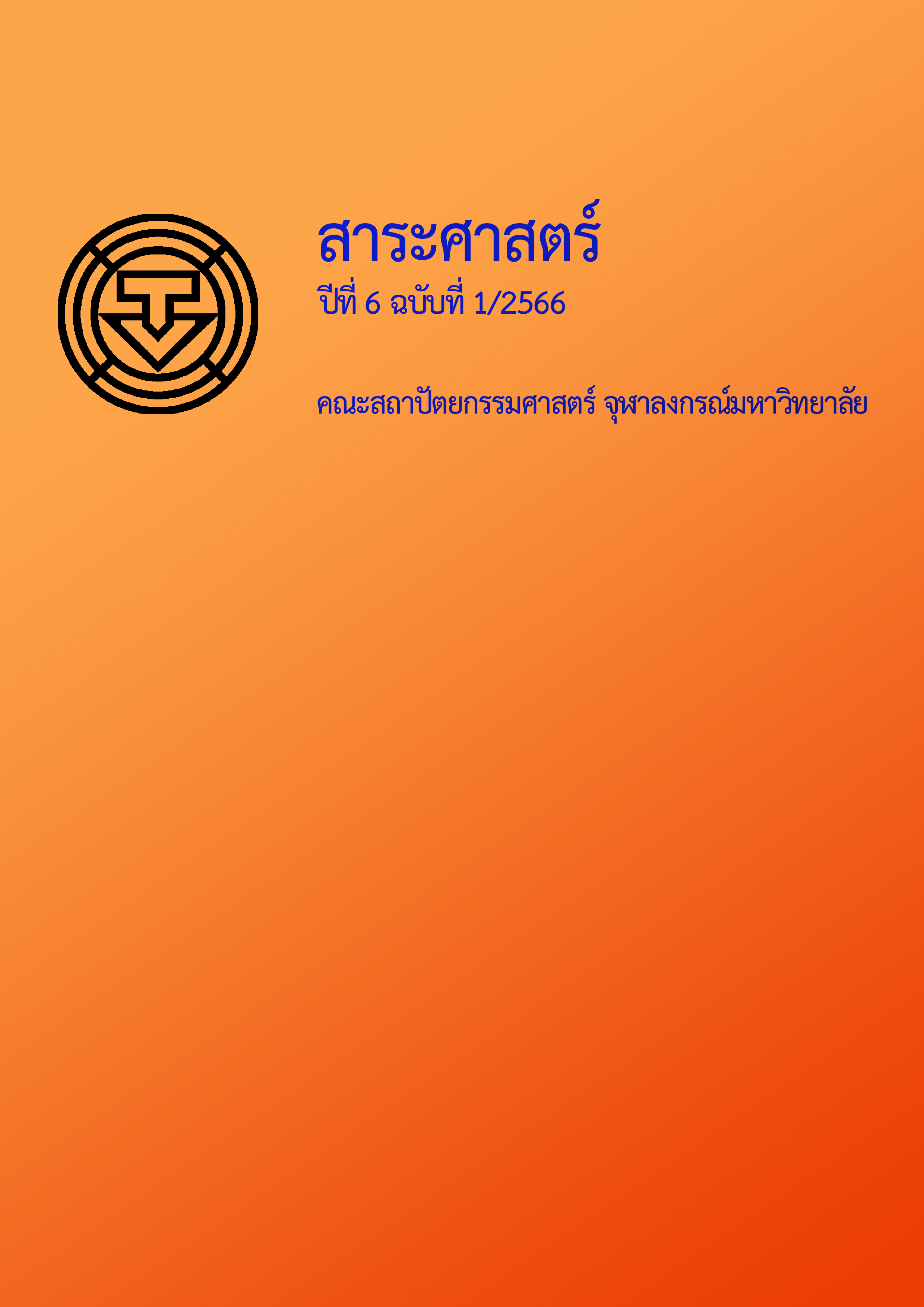Impacts of Circadian Lighting Design on Energy Consumption of Office Buildings in Thailand
Main Article Content
Abstract
Nowadays, building design pays more attention to the quality of building users’ lives as 90% of people's daily activities are spent indoor. Designing appropriate indoor lighting for the biological clock is a way to promote good health for users. The indoor lighting consists of natural and artificial light which has an impact on the energy consumption of the building including air conditioning and lighting energy consumption. This research aims to study circadian lighting design variables referring to “Circadian Lighting” title in WELL Building Standard v.2 by analyzing the overall energy consumption of the building and proposing guidelines of the suitable lighting design for the biological clock which can be useful in terms of decision making for architects. The research utilizes the office building model that has different shapes, proportions of the opening, type of glass, and interior lighting luminaire layouts in order to calculate Spatial Daylight Autonomy (sDA), Vertical Illuminance (Ev), Equivalent Melanopic Lux (EML) and simulates the building’s overall energy consumption by computer programs i.e., DesignBuilder and Dialux Evo.
The study of lighting for biological clocks is still in its early stages. From the literature review, the impact on the building's overall energy consumption from the air conditioning and lighting system has rarely been studied. When designing buildings to meet the Circadian Lighting criteria, according to the study, it was found that the building's overall energy consumption is not correlated with EML as the EML in accordance with WELL building standard is calculated mainly based on the vertical illuminance of artificial light without the consideration of natural light. However, the overall energy consumption of the building has to be considered with both artificial lighting energy consumption and air conditioning energy consumption which is affected by heat entering the building from natural light. The buildings that achieve the circadian lighting standard or meet the minimum criteria of EML, compared with the prototype building, have both cases that the overall energy consumption of the building increases by 0.49%-0.88% and cases where the overall energy consumption decreases by 3.53-4.55%. In addition, the utilization of artificial lighting to achieve the right amount of light for circadian lighting in the office building increases lighting energy consumption by 1.2 times, compared with the prototype building. Accordingly, if the EML from natural light can be combined with that from artificial light, it is likely that less electric lighting power is needed in order to meet the Circadian Lighting of WELL standard.
Article Details
References
กฎกระทรวง ฉบับที่ 39 (พ.ศ. 2537) ออกตามความในพระราชบัญญัติควบคุมอาคาร พ.ศ. 2522. (2537, 13 มิถุนายน). ราชกิจจานุเบกษา. เล่ม 111 ตอนที่ 23กหน้า 37-42.
เกษียร ธรานนท์. (2551). รายงานวิจัยฉบับสมบูรณ์ผลของความร้อนที่เกิดจากการนำแสงธรรมชาติมาใช้ในอาคาร โดยผ่านช่องหน้าต่างกระจกด้านข้าง. คณะสถาปัตยกรรมศาสตร์ มหาวิทยาลัยเทคโนโลยีราชมงคลธัญบุรี.
จิณห์วรา อรัณย์ชนายุธ. (2561). แนวทางการออกแบบการใช้แสงธรรมชาติร่วมกับแสงประดิษฐ์ในอาคารสำนักงานให้มีความเหมาะสมกับนาฬิกาชีวิตของประเทศไทย [วิทยานิพนธ์ปริญญามหาบัณฑิต ไม่ได้ตีพิมพ์]. มหาวิทยาลัยธรรมศาสตร์.
จิณห์วรา อรัณย์ชนายุธ. (2564). แนวทางการใช้เกณฑ์การประเมินแสงธรรมชาติที่มีผลต่อนาฬิกาชีวิตในประเทศไทย. JARS, 18(1), 115-130.
ณัฐพงษ์ โต๊ะพาน. (2548). แนวทางการออกแบบอาคารสำนักงานเพื่อป้องกันปัญหาคุณภาพอากาศภายใน : ก๊าซคาร์บอนไดออกไซด์ [วิทยานิพนธ์ปริญญามหาบัณฑิต ไม่ได้ตีพิมพ์]. มหาวิทยาลัยธรรมศาสตร์.
ณัฐภูมิ รับคำอินทร์. (2552). อิทธิพลของสัดส่วนและทิศทางอาคารที่มีผลต่อการใช้พลังงานในอาคาร [วิทยานิพนธ์ปริญญามหาบัณฑิต ไม่ได้ตีพิมพ์]. จุฬาลงกรณ์มหาวิทยาลัย.
บริรักษ์ อินทรกุลไชย. (2562). การเพิ่มแสงธรรมชาติภายในห้องพักอาจารย์ คณะสถาปัตยกรรมศาสตร์ ผังเมืองและนฤมิตศิลป์ มหาวิทยาลัยมหาสารคาม. วารสารสิ่งแวดล้อมสรรค์สร้างวินิจฉัย คณะสถาปัตยกรรมศาสตร์ มหาวิทยาลัยขอนแก่น, 18(1), 69-89.
อวิรุทธ์ ศรีสุธาพรรณ. (2565). การศึกษาการออกแบบร่วมกันระหว่างการวิเคราะห์แสงธรรมชาติแบบรายปีตามสภาพภูมิอากาศและการออกแบบแสงเพื่อนาฬิกาชีวภาพ. JARS, 19(1), 21-40.
Ahmad, R. M., & Reffat, R. M. (2018). A comparative study of various daylighting systems in office buildings for improving energy efficiency in Egypt. Journal of Building Engineering, 18, 360-376. https://doi.org/https://doi.org/10.1016/j.jobe.2018.04.002
ASHRAE. (2016). Standard 90.1-2016, energy standard for buildings except low-rise residential buildings. https://ashrae.iwrapper.com/ASHRAE_PREVIEW_ONLY_STANDARDS/STD_90.1_2016_IP
Borisuit, A. (2013). The impact of light including non-image forming effects on visual comfort [Unpublished doctoral dissertation]. Swiss Federal Institute of Technology Lausanne.
Hengrasmee, N. (2019). Circadian lighting design criteria for health and well-being in Thai built environment [Unpublished doctoral dissertation]. Naresuan University.
International WELL Building Institute [IWBI]. (2022). The WELL building standard version 2. https://v2.wellcertified.com/en/wellv2/overview
Ticleanu, P. L. C. (2019). Lighting for circadian rhythm (Vol. 19). The BRE Trust.
van Bommel, W., & Beld, G. J. (2004). Lighting for work: A review of visual and biological effects. Lighting Research & Technology -LIGHTING RES TECHNOL, 36, 255-269. https://doi.org/10.1191/1365782804li122oa
Wymelenberg, K. V. D. (2012). Pattern of occupant interation with window blinds: A literature review. Energy and Buildings, 51, 164-176.
Zeng, Y., Sun, H., & Lin, B. (2021). Optimized lighting energy consumption for non-visual effects: A case study in office spaces based on field test and simulation. Building and Environment, (205), 1-16. https://doi.org/https://doi.org/10.1016/j.buildenv.2021.108238


